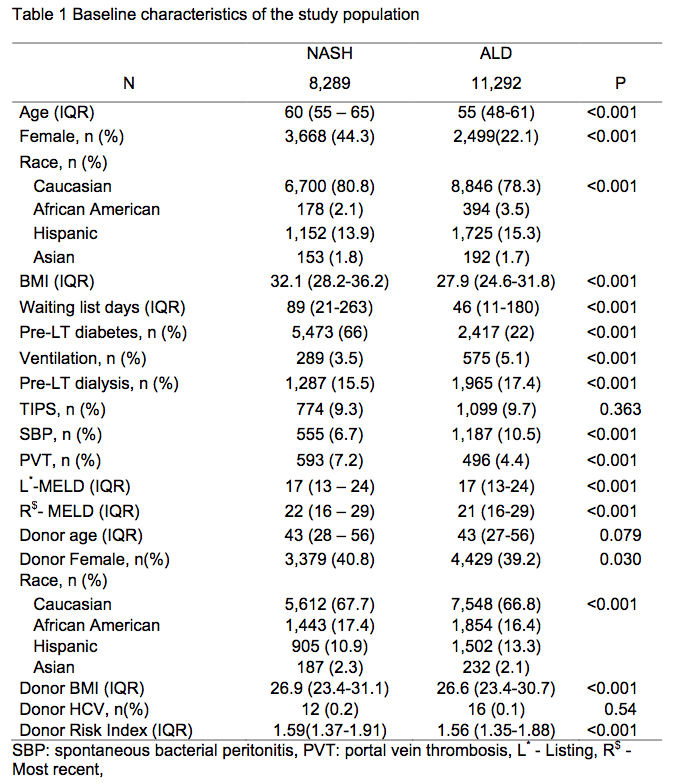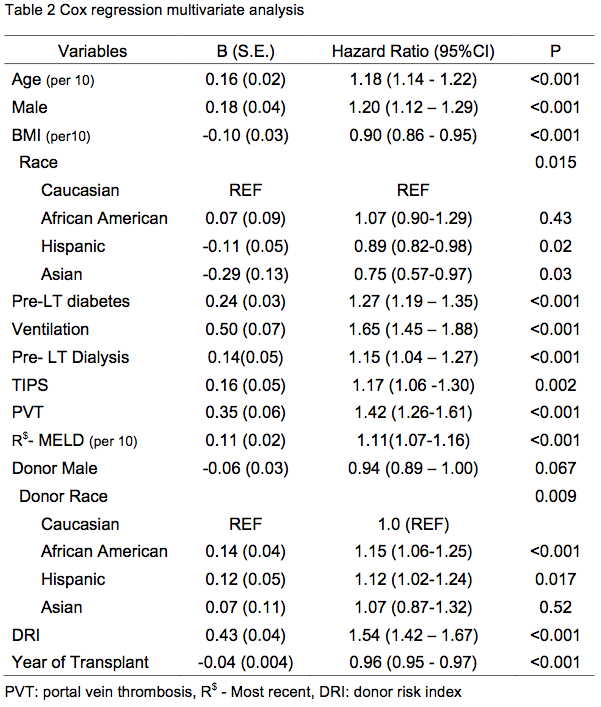Recent Trends and Outcomes of Liver Transplantation for Non-alcoholic Steatohepatitis versus Alcohol Liver Disease in the United States: Obesity Might be Protective
Surgery, Westchester Medical Center/New York Medical College, Valhalla, NY
Meeting: 2021 American Transplant Congress
Abstract number: 1108
Keywords: Alcohol, Liver transplantation, Obesity, Outcome
Topic: Clinical Science » Liver » Liver: Recipient Selection
Session Information
Session Name: Liver: Recipient Selection
Session Type: Poster Abstract
Session Date & Time: None. Available on demand.
Location: Virtual
*Purpose: Nonalcoholic steatohepatitis (NASH) and alcohol liver disease (ALD) are rapidly growing indications for liver transplantation (LT). The recent trends and outcomes in NASH and ALD are limited.
*Methods: We analyzed data from the United Network for Organ Sharing (UNOS) between 2002 and 2016. We excluded hepatitis C virus co-infection and compared the trends and outcomes in NASH and ALD.
*Results: 19,581 LTs were performed during the study period, of which 8,289 LTs were for NASH and 11,292 LTs were for ALD. Compared to ALD, NASH group had older median recipient age (60 vs 55, p<0.01), female dominance (44 vs 22%, p<0.01), high percentage of Caucasian (81 vs 78%, p<0.01) and higher median BMI (32 vs 28, p<0.01). In NASH, Pre-LT diabetes rate was significantly higher, but ventilation rate and dialysis rate were significantly lower (66 vs 21%; 3.5 vs 5.1%; 16 vs 17%; p<0.01, respectively). Compared to ALD, the outcomes of NASH were inferior in five-year graft survival and five-year overall survival (77 vs 78%, p=0,03; 80 vs 81%, p<0.01). In cox regression multivariable analysis for five-year graft survival, higher recipient age, male, Caucasian, pre-LT diabetes, pre-LT dialysis, ventilation on LT, Transjugular intrahepatic portosystemic shunt (TIPS), portal vein thrombosis (PVT), higher MELD score, African American or Hispanic donor and higher donor risk index (DRI) were significantly associated with negative outcomes. Hispanic or Asian recipient, higher recipient BMI and recent transplant year had significantly protective effects. The etiology of NASH vs ALD did not show significant difference in multivariable analysis (p=NS).
*Conclusions: NASH and ALD had comparable post-transplant outcomes in graft survival and overall survival. Pre-transplant diabetes, dialysis, ventilation status, TIPS, PVT and DRI were associated with poor outcomes. We also showed the improvement of LT in recent years and protective effects of recipient BMI.
To cite this abstract in AMA style:
Okumura K, Lee I, Sogawa H, Veillette G, John D, Diflo T, Bodin R, Wolf D, Nishida S. Recent Trends and Outcomes of Liver Transplantation for Non-alcoholic Steatohepatitis versus Alcohol Liver Disease in the United States: Obesity Might be Protective [abstract]. Am J Transplant. 2021; 21 (suppl 3). https://atcmeetingabstracts.com/abstract/recent-trends-and-outcomes-of-liver-transplantation-for-non-alcoholic-steatohepatitis-versus-alcohol-liver-disease-in-the-united-states-obesity-might-be-protective/. Accessed December 25, 2025.« Back to 2021 American Transplant Congress


